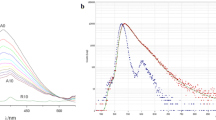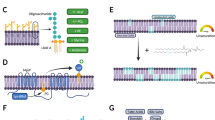Abstract
Probing drug/lipid interactions at the molecular level represents an important challenge in pharmaceutical research, drug discovery and membrane biophysics. Previous studies showed that enrofloxacin metalloantibiotic has potential as an antimicrobial agent candidate, since it exhibits antimicrobial effect comparable to that of free enrofloxacin but a different translocation route. These differences in uptake mechanism can be paramount in counteracting bacterial resistance. In view of lipids role in bacterial drug uptake, the interaction of these compounds with different Escherichia coli model membranes were studied by fluorescence spectroscopy. Partition coefficients determined showed that lipid/antibiotic interactions were sensitive to liposomes composition and that the metalloantibiotic had a higher partition than free enrofloxacin. These results corroborate the different mechanism of entry proposed and can be rationalized on the basis that an electrostatic interaction between the metalloantibiotic positively charged species, present at physiological pH, and the lipids negatively charged head groups clearly promotes the lipid/antimicrobial association.



Similar content being viewed by others
References
Aarestrup FM (2006) Antimicrobial resistance in bacteria of animal origin. ASM Press, Washington, DC
Alvarez AI, Pérez M, Prieto JG, Molina AJ, Real R, Merino G (2008) Fluoroquinolone efflux mediated by ABC transporters. J Pharm Sci 97:3483–3493
Arouria A, Datheb M, Blumea A (2009) Peptide induced demixing in PG/PE lipid mixtures: a mechanism for the specificity of antimicrobial peptides towards bacterial membranes? Biochim Biophys Acta Biomembr 1788:650–659
Bensikaddour H, Snoussi K, Lins L, Bambeke FV, Tulkens PM, Brasseur R, Goormaghtigh E, Mingeot-Leclercq MP (2008) Interactions of ciprofloxacin with DPPC and DPPG: fluorescence anisotropy, ATR-FTIR and 31P NMR spectroscopies and conformational analysis. Biochim Biophys Acta Biomembr 1778:2535–2543
Bhunia A, Domadia PN, Torres J, Hallock KJ, Ramamoorthy A, Bhattacharjya S (2010) NMR structure of pardaxin, a pore-forming antimicrobial peptide, in lipopolysaccharide micelles: mechanism of outer membrane permeabilization. J Biol Chem 285:3883–3895
Bilski P, Martinez LJ, Koker EB, Chignell CF (1998) Influence of solvent polarity and proticity on the photochemical properties of norfloxacin. Photochem Photobiol 68:20–24
Bryan LE, Bedard J (1991) Impermeability to quinolones in gram-positive and gram-negative bacteria. Eur J Clin Microbiol 10:232–239
Cheng JTJ, Hale JD, Elliott M, Hancock REW, Straus SK (2011) The importance of bacterial membrane composition in the structure and function of aurein 2.2 and selected variants. Biochim Biophys Acta Biomembr 1808:622–633
Coutinho A, Prieto M (1995) Self-association of the polyene antibiotic nystatin in dipalmitoylphosphatidylcholine vesicles: a time-resolved fluorescence study. Biophys J 69:2541–2557
Cuquerella MC, Miranda MA, Bosca F (2006) Role of excited state intramolecular charge transfer in the photophysical properties of norfloxacin and its derivatives. J Phys Chem A 110:2607–2612
Dennison SR, Morton LHG, Harris F, Phoenix DA (2008) The impact of membrane lipid composition on antimicrobial function of an [alpha]-helical peptide. Chem Phys Lipids 151:92–102
Djurdjevic PT, Jelikicstankov M, Stankov D (1995) Fluorescence reaction and complexation equilibria between norfloxacin and aluminum(III) ion in chloride medium. Anal Chim Acta 300:253–259
Drakopoulos AI, Ioannou PC (1997) Spectrofluorometirc study of the acid–base equilibria and complexation behavior of the fluoroquinolones antibiotics ofloxacin, norfloxacin, ciprofloxacin and pefloxacin in aqueous solution. Anal Chim Acta 354:197–204
Efthimiadou EK, Sanakis Y, Katsarou M, Raptopoulou CP, Karaliota A, Katsaros N, Psomas G (2006) Neutral and cationic mononuclear copper(II) complexes with enrofloxacin: structure and biological activity. J Inorg Biochem 100:1378–1388
Efthimiadou EK, Sanakis Y, Katsaros N, Karaliota A, Psomas G (2007) Transition metal complexes with the quinolone antibacterial agent pipemidic acid: synthesis, characterization and biological activity. Polyhedron 26:1148–1158
Epand RM, Epand RF (2009a) Domains in bacterial membranes and the action of antimicrobial agents. Mol Biosyst 5:580–587
Epand RM, Epand RF (2009b) Lipid domains in bacterial membranes and the action of antimicrobial agents. Biochim Biophys Acta Biomembr 1788:289–294
Epand RM, Epand RF (2011) Bacterial membrane lipids in the action of antimicrobial agents. J Pept Sci 17:298–305
Fresta M, Guccione S, Beccari AR, Furneri PM, Puglisi G (2002) Combining molecular modeling with experimental methodologies: mechanism of membrane permeation and accumulation of ofloxacin. Bioorg Med Chem 10:3871–3889
Haines TH (2009) A new look at cardiolipin. Biochim Biophys Acta Biomembr 1788:1997–2002
Hamill P, Brown K, Jenssen H, Hancock RE (2008) Novel anti-infectives: is host defence the answer? Curr Opin Biotechnol 19:628–636
Hoch FL (1992) Cardiolipins and biomembrane function (review). Biochim Biophys Acta 1113:71–133
Hooper DC (1999) Mechanisms of fluoroquinolone resistance. Drug Resist Updat 2:38–55
Hopkins K, Davies R, Threlfall E (2005) Mechanisms of quinolone resistancein Escherichia coli and Salmonella: recent developments. Int J Antimicrob Agents 25:358–373
Kawai Y, Matsubayashi K, Hakusui H (1996) Interaction of quinolones with metal cations in aqueous solution. Chem Pharm Bull 44:1425–1430
Lakowicz J (1999) Principles of fluorescence spectroscopy. Kluwer, New York
Lewis RNAH, McElhaney RN (2009) The physicochemical properties of cardiolipin bilayers and cardiolipin-containing lipid membranes. Biochim Biophys Acta Biomembr 1788:2069–2079
Lindner B, Wiese A, Brandenburg K, Seydel U, Dalhoff A (2002) Lack of interaction of fluoroquinolones with lipopolysaccharides. Antimicrob Agents Chemother 46:1568–1570
Lizondo M, Pons M, Gallardo M, Estelrich J (1997) Physicochemical properties of enrofloxacin. J Pharmaceut Biomed 15:1845–1849
Lohner K (2009) New strategies for novel antibiotics: peptides targeting bacterial cell membranes. Gen Physiol Biophys 28:105–116
Lohner K, Blondelle SE (2005) Molecular mechanisms of membrane perturbation by antimicrobial peptides and the use of biophysical studies in the design of novel peptide antibiotics. Comb Chem High Throughput Screen 8:241–256
Lohner K, Latal A, Degovics G, Garidel P (2001) Packing characteristics of a model system mimicking cytoplasmic bacterial membranes. Chem Phys Lipids 111:177–192
Lopes SC, Goormaghtigh E, Cabral BJ, Castanho MA (2004) Filipin orientation revealed by linear dichroism. Implication for a model of action. J Am Chem Soc 126:5396–5402
Lopes S, Neves C, Eaton P, Gameiro P (2010) Cardiolipin, a key component to mimic the E. coli bacterial membrane in model systems revealed by dynamic light scattering and steady-state fluorescence anisotropy. Anal Bioanal Chem 398:1357–1366
Mahendran KR, Hajjar E, Mach T, Lovelle M, Kumar A, Sousa I, Spiga E, Weingart H, Gameiro P, Winterhalter M (2010) Molecular basis of enrofloxacin translocation through OmpF, an outer membrane channel of Escherichia coli—when binding does not imply translocation. J Phys Chem B 114:5170–5179
Maniti O, Alves I, Trugnan G, Ayala-Sanmartin J (2010) Distinct behaviour of the homeodomain derived cell penetrating peptide penetratin in interaction with different phospholipids. PLoS One 5:e15819
Martinez M, McDermott P, Walker R (2006) Pharmacology of the fluoroquinolones: a perspective for the use in domestic animals. Vet J 172:10–28
Meras ID, Pena AMdl, Caceres MIR, Lopez FS (1998) Simultaneous fluorometric determination of nalidixic acid and 7-hydroxymethylnalidixic acid by partial least squares calibration. Talanta 45:899–907
Mileykovskaya E (2007) Subcellular localization of Escherichia coli osmosensory transporter ProP: focus on cardiolipin membrane domains. Mol Microbiol 64:1419–1422
Mitchell MA (2006) Enrofloxacin. J Exot Pet Med 15:66–69
Murzyn K, Róg T, Pasenkiewicz-Gierula M (2005) Phosphatidylethanolamine–phosphatidylglycerol bilayer as a model of the inner bacterial membrane. Biophys J 88:1091–1103
Pagès J, James C, Winterhalter M (2008) The porin and the permeating antibiotic: a selective diffusion barrier in gram-negative bacteria. Nat Rev Microbiol 6:893–903
Park H-R, Oh C-H, Lee H-C, Lim SR, Yang K, Bark K-M (2004) Spectroscopic properties of various quinolone antibiotics in aqueous—organic solvent mixtures. Photochem Photobiol 80:554–564
Pate MN, Parmar PA, Gandhi DS (2010) Square pyramidal copper(II) complexes with forth generation fluoroquinolone and neutral bidentate ligand: structure, antibacterial, SOD mimic and DNA-interaction studies. Bioorg Med Chem 18:1227–1235
Pávez P, Herrera B, Toro-Labbé A, Encinas MV (2007) Structure and medium effects on the photochemical behavior of nonfluorinated quinolone antibiotics. Photochem Photobiol 83:511–519
Pozo Navas B, Lohner K, Deutsch G, Sevcsik E, Riske KA, Dimova R, Garidel P, Pabst G (2005) Composition dependence of vesicle morphology and mixing properties in a bacterial model membrane system. Biochim Biophys Acta Biomembr 1716:40–48
Rodrigues C, Gameiro P, Reis S, Lima JLFC, Castro Bd (2002) Interaction of grepafloxacin with large unilamellar liposomes: partition and fluorescence studies reveal the importance of charge interactions. Langmuir 18:10231–10236
Romantsov T, Guan Z, Wood JM (2009) Cardiolipin and the osmotic stress responses of bacteria. Biochim Biophys Acta Biomembr 1788:2092–2100
Ross DL, Riley CM (1994) Dissociation and complexation of the fluoroquinolone antimicrobials—an update. J Pharm Biomed 12:1325–1331
Santos NC, Prieto M, Castanho MARB (2003) Quantifying molecular partition into model systems of biomembranes: an emphasis on optical spectroscopic methods. Biochim Biophys Acta Biomembr 1612:123–135
Saraiva R, Lopes S, Ferreira M, Novais F, Pereira E, Feio MJ, Gameiro P (2010) Solution and biological behaviour of enrofloxacin metalloantibiotics: a route to counteract bacterial resistance? J Inorg Biochem 104:843–850
Schlame M (2008) Glycerolipids. Cardiolipin synthesis for the assembly of bacterial and mitochondrial membranes (thematic review). J Lipid Res 49:1607–1620
Seral C, Barcia-Macay M, Mingeot-Leclercq MP, Tulkens PM, Bambeke FV (2005) Comparative activity of quinolones (ciprofloxacin, levofloxacin, moxifloxacin and garenoxacin) against extracellular and intracellular infection by Listeria monocytogenes and Staphylococcus aureus in J774 macrophages. J Antimicrob Chemother 55:511–517
Tossi A, Sandri L, Giangaspero A (2000) Amphipathic, alpha-helical antimicrobial peptides. Biopolymers 55:4–30
Valeur B (2002) Molecular fluorescence: principles and applications. Wiley, New York
Van Bambeke F, Michot JM, Van Eldere J, Tulkens PM (2005) Quinolones in 2005: an update. Clin Microbiol Infect 11:256–280
Weitman H, Roslaniec M, Frimer AA, Afri M, Freeman D, Mazur Y, Ehrenberg B (2001) Solvatochromic effects in the electronic absorption and nuclear magnetic resonance spectra of hypericin in organic solvents and in lipid bilayers. Photochem Photobiol 73:110–118
Yeagle P (1987) The membranes of cells. Academic Press, New York
Acknowledgments
Partial financial support for this work was provided by FCT PTDC/SAU-FAR/111414/2009. SCL thanks FCT for a SFRH/BPD/34262/2006 fellowship.
Author information
Authors and Affiliations
Corresponding author
Rights and permissions
About this article
Cite this article
Ribeiro, C., Lopes, S.C. & Gameiro, P. New Insights into the Translocation Route of Enrofloxacin and Its Metalloantibiotics. J Membrane Biol 241, 117–125 (2011). https://doi.org/10.1007/s00232-011-9368-4
Received:
Accepted:
Published:
Issue Date:
DOI: https://doi.org/10.1007/s00232-011-9368-4




